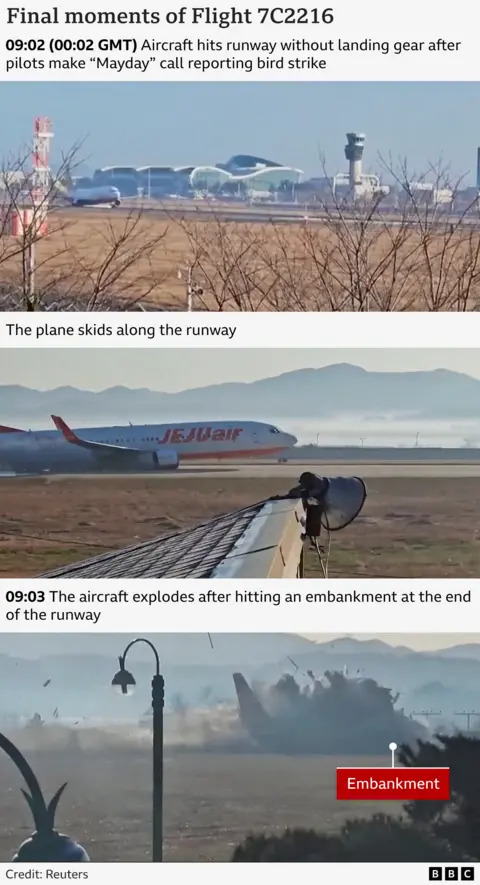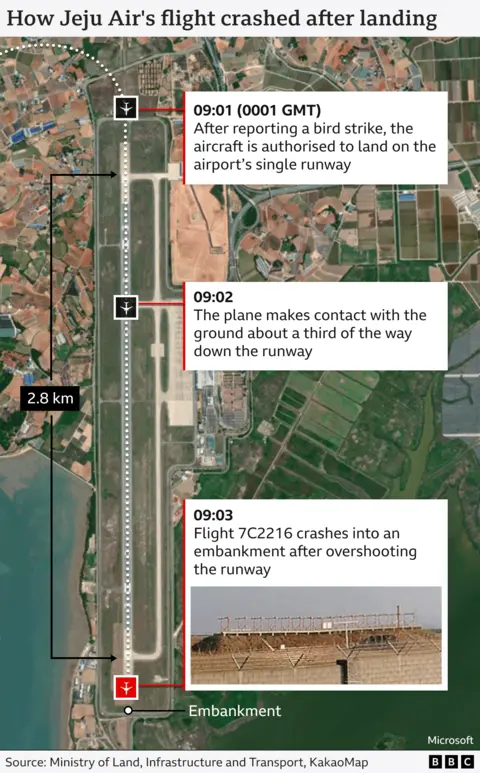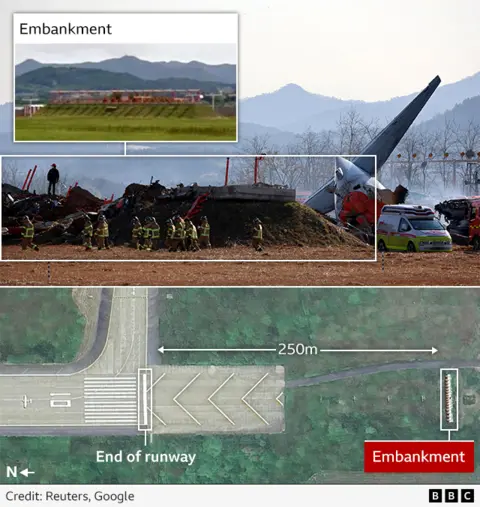Why was there a wall next to the runway?

Aviation experts have raised questions about an “unusual” concrete wall near the runway and its role in the South Korean airliner crash that killed 179 people.
Footage shows a Jeju Air plane skidding off the runway before crashing into a wall and bursting into flames at Muan International Airport on Sunday.
Authorities investigating the cause of South Korea’s worst plane crash are considering the importance of a concrete wall about 250m (820ft) from the end of the road.
Air safety expert David Learmount said that, had the “obstacle” not been present, the plane “would have come to rest with most – perhaps all – of those on board still alive”.
The pilot reported that the plane had hit a bird and he withdrew the first place he had landed and asked for permission to land on the other side.
The plane descended a short distance down the 2,800m runway and appeared to land without using its wheels or other landing gear.
Mr Learmount said the landing was “as good as a flapless/gearless touch: wings level, nose not too high to avoid breaking the tail” and the plane suffered no major damage as it skidded down the runway.
“The reason why so many people died was not because of landing like that, but because the plane collided with a heavy obstacle on the other side of the road,” he said.

One aviation analyst agreed. Captain Ross Aimer, CEO of Aero Consulting Experts, told Reuters: “Unfortunately, that thing was the reason everyone was killed, because they hit the concrete. It shouldn’t have happened.”
Christian Beckert, a Lufthansa pilot based in Munich, called the concrete structure “unusual”, saying: “Normally, in an airport with a runway at the end, you don’t have a wall.”
The concrete structure houses a navigation system that helps the aircraft land – known as a navigation system – according to South Korea’s Yonhap News Agency.
At 4m high, it was covered in dirt and raised to maintain the level of the area and the runway to ensure it works properly, Yonhap reported.
The Ministry of Transport in South Korea said that some airports in the country and some overseas have machines installed in concrete. However, the officials will check whether they should have been made of light materials that will break easily in a collision.
Chris Kingswood, a 48-year-old pilot who flew the same type of aircraft involved in the crash, told BBC News: “Obstacles within a certain distance of the runway need to be easy, that is when the plane is moving. beating them for breaking in.
“It seems unusual for something to be that strong. The plane, as I understand it, was traveling at high speed, it was going a long way down the runway, so it would have gone a long way at the end of the runway… so where do you draw the line with that?
“Airplanes are not rigid structures – by design, they’re easy to make flyable. They’re not really designed to go very fast on their belly so any kind of structure can cause the fuselage to come apart and it’s a disaster.

“Fuel is stored in the wings so once the wing is broken, firepower is critical.
“So it goes without saying that if the wall hadn’t been there, it would have been a completely different outcome.”
Mr Kingswood said he would be “surprised if the airport did not meet all requirements in line with industry standards”.
“I suspect that if we go around the airfields at the major international airports… we will find many obstacles that can be equally accused of introducing risks,” he added.
However former pilot John Cox, chief executive of Safety Operating Systems, said the runway design “did not” meet industry best practices, which prohibit any solid structure within at least 300m (984ft) of the end of the runway.
After the accident, it was revealed that the words in the operating manual of the Muan International Airport, which was uploaded in early 2024, said that the concrete edge was too close to the end of the runway.
The document, prepared by Korea Airports Corp, recommended that the operating environment be updated during the planned expansion.
South Korea’s director-general of aviation policy, Kim Hong-rak, said the government would “review the relevant regulations and its application”.
Aviation analyst Sally Gethin questioned whether the pilot knew the obstacle was there, especially if the plane was coming from the opposite direction on the normal approach.
He told BBC News: “We need to know, did (the pilots) know there was this hard edge at the end?
“If they were ordered by the control tower to postpone the use of the runway for the second time, that should come from the investigation of the black boxes.
“I think there are a lot of questions.”

At a press conference on Tuesday, Jeju Air CEO Kim Yi-bae would not be drawn when asked about the concrete wall.
When asked by a reporter if he thought the wall was the cause of the disaster, he did not give a specific answer but rather said that it is correct to call the plane crash the Jeju Air disaster, rather than the Muan Air disaster.
Source link




